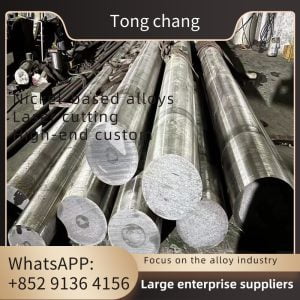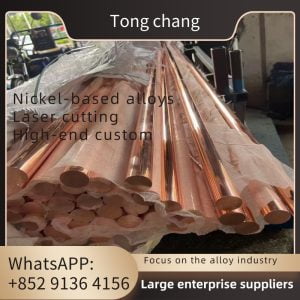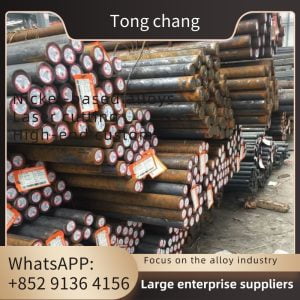| Product Name: | Copper Alloy Low Finned Tube | Standard: | ASTM B111, ASME SB111 |
|---|---|---|---|
| Tube Material: | C70600 / C71500 / C12200 / C12100 / C68700 / C44300 | Main Tube Size: | OD: 15.88-63.5mm , Thk.1.65-4.57mm |
| Tube W.T.: | 1.65-4.57 | Fin Qty: | Depend On Client Request |
| Fin Thickness: | 0.2mm~3.0mm | Fin Height: | 1.6mm ~60mm |
| Length: | Depend On Client Request | End: | Plain End, Beveled End |
| Application: | Oil Cooler, Pre Heater, Radiator, Air Conditioner Evaporator And Condenser, Steam System | ||
| High Light: | astm b111 aluminum finned tube, c71500 aluminum finned tube, astm b111 aluminium finned tubes | ||
ASTM B111 / ASME SB111 UNS C70600 Copper Nickel 90/10 Low Finned Tube for Oil Cooler
Low finned tubes come in different fin geometries to suit specific applications. The most commonly used types include plain fins (straight fins without any patterns), spiral fins (fins in a helical pattern along the tube), and longitudinal fins (fins running parallel to the tube axis). Each fin type offers different advantages in terms of heat transfer performance and resistance to fouling.
Low finned tubes are typically manufactured using processes such as extrusion, roll forming, or embedded fin techniques. Extrusion is the most commonly used method, where fins are formed by squeezing the tube material through specially designed dies. Roll forming involves passing a flat strip of material through a set of rollers to create fins, which are then wound around the tube. Embedded fin techniques involve bonding separate fin strips onto the tube surface.
Benefits of Low Finned Tubes
1. Offers 2.5-3 times the external surface area of bare tube
2. Enhanced heat exchanger efficiency means less tube is required to accomplish the same heat transfer as a bare tube
3. Low finned tube can increase the performance of an existing exchanger without the difficult and expensive task of building new shells etc
4. Reduced space and weight can be extremely valuable in offshore production or high elevation distillation columns. Low finned technology can transform large shell and tube exchangers into compact heat exchangers
Technical Specifications- Low Finned Tube
It is possible to produce low finned tubes with different materials and dimensions, on customer request.
| Standard Dimensions – Low Finned Tubes | |||||||
| Outside Diameter | Thickness | Length | Fin Density | ||||
| (mm) | (inch) | (mm) | (BWG) | (m) | (ft) | (fins/inch) | (fins/m) |
| 12.00~ 60.00 | 0.47~ 2.4 | 0.635 ~ 4.572 | 23 ~ 7 | 0.3 ~ 25 | 1 ~ 82 | 8 ~ 40 | 315 ~ 1575 |
| Materials – Low Finned Tubes | |
| Carbon Steel | SA 179 / A 179 |
| Carbon Steel | SA 210 / A 210 |
| Carbon Steel | SA 334 / A 334 |
| Stainless Steel | SA 213 / A 213 |
| Duplex Stainless Steel | SA 789 / A 789 |
| Copper & Cu Alloys | SB 111 / B 111 |
| Titanium & Ti Alloys | SB 338 / B 338 |
| For different materials please contact our sales department. | |
| Standard Technical Specifications – Low Finned Tubes | |
| Carbon Steel | ASTM A 498 |
| Stainless Steel | ASTM A 1012 |
| Copper and Copper Alloys | ASTM B 359 |
| Titanium | ASTM B 891 |
| For different materials please contact our sales department. | |
| ALSO AVAILABLE – LOW FINNED TUBES | |
| Condenser Tube "Y-fin" | Evaporator Tube "T-fin" |
| Inner Grooved (IG) Low Fin Tube | Inner Grooved (IG) Y-Fin / T-fin Tube |
| U-Bent Low Fin Tube | Annealed Low Fin Tube |
| Inspections and Tests – Low Finned Tubes | |
| Chemical Composition | |
| Mechanical Properties | |
| Hydrostatic Test | |
| Pneumatic Test | |
| Boroscopic Inspection | |
| Eddy Current Test | |
Our direct clients
End user, EPC companies, Trading companies. Manufacturers of air cooler, fire heater, heat exchanger, marine boiler, economizer, power plant boiler, waste heat revovery unit, air heater etc.
Applications of Low Fin Tube
1.Heat exchangers for power plants (electric, nuclear, thermal and geothermal power plants)
2.High corrosive systems (condensers, evaporators, sea water desalinations, fertilizing, urea systems, ammonia, gas, corrosive acids)
3.Chemical and petrochemical industries
4.Food processing and refrigeration industries








